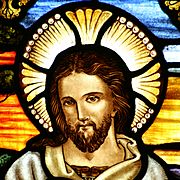East-West Schism facts for kids
The East-West Schism (sometimes also called Great Schism) describes how Christianity developed into two big branches in the Middle Ages. The Western part later became the Roman Catholic Church. The Eastern part is known as the Eastern Orthodox Church. During the centuries views on politics and theology developed differently in several ways. It is distinct from the earlier schism that separated Oriental Orthodoxy from the church that split in half later.
During the 5th and 6th Centuries the East and West became isolated from each other due to the invasions of the Balkan peninsula. They also had different languages. Latin was the most important language in the West. The East mainly spoke the Greek language. Because of this, talking to each other was difficult. The West came under Frankish influence (as opposed to Byzantine) in the 700s.
These were just some of the issues plaguing the Eastern and Western Christians that led to the Great Schism. It seems that even after 1054 relations between the east and west were not completely unfriendly, and the common peasant was probably not immediately affected by the schism.
Background
To understand the meaning of East-West Schism, it is useful to understand the meaning of schism. In very simple words, when differences arise among one group of persons or organizations and they divide themselves into two or more groups, this is schism.
The term East-West Schism describes the division which happened in Christianity. The Christian church became divided into two major groups: Roman Catholicism and Eastern Orthodoxy. Most people accept that it happened in 1054. However, this separation was the result of differences that had begun many years before. One difference was the "filioque clause" in the Nicene Creed. This stated that the Holy Spirit came from the Father and the Son, although the original creed declared that It came from just the Father. One major reason for the division concerned the authority of the pope. The Eastern Orthodox group was of the opinion that the pope's authority over them was only honorary, and the pope had real authority only over the western Christians.
However instances of open division on doctrinal questions as well as daily matters had occurred long before the Great Schism of 1054. Leading up to the schism, Pope Leo IX (1002-1054) sent forth a party led by Cardinal Humbert of Silva Candida to talk through the obvious problems between the papacy and Constantinople. Michael Cerularius, the Patriarch of Constantinople, rejected the claims put forward by the papal committee. Those from the western side of the church accused Constantinople of having altered the Nicene Creed, and those from the eastern side accused the western church of altering the creed. This in turn led to Cardinal Humbert putting forward a Bull of Excommunication against Michael Cerularius on the altar of the Hagia Sophia, and the Great Schism became official.
Nicene creed
The Roman Catholic Church changed the Nicene creed. It inserted a passage that is known as the Filioque. The Creed in its original form reads
I believe...in the Holy Spirit, the Lord, the Giver of Life,who proceeds (comes) from the Father,
who with the Father and the Son together is worshipped and together glorified.
In the West, the Creed was changed to read
I believe...in the Holy Spirit, the Lord, the Giver of Life,who proceeds from the Father and from the son...
Some people said that the Holy Spirit was a creature. The filioque became a question of theological controversy since it was added to the Creed without an ecumenical council's approval.
Role of the pope
There were many bishops in the church, and in the East the Pope was considered the "first among equals", but Rome claimed that the Pope was the primary Apostolic see, being that of Peter. At first the Eastern Orthodox did not mind the Pope's claim for power over the West - as long as his power stayed in the West. But it came to pass that the Pope decided he also had power over Eastern Christendom as well and he tried to enforce his power on the eastern Patriarchates. A letter written in 865 by Pope Nicholas claims the Pope's power extends "over all the earth, that is, over every church". Pope Nicholas also went beyond his powers as stated in Canon 111 of the Council of Sardica (343) when he overturned a verdict and ordered a retrial on a matter concerning Photius and St. Ignatius, two Patriarchs of Constantinople. This was as a result of petitions to Rome by backers of Ignatius. However, it should be noted that not all the Popes after Nicholas were as extreme - that is, until Pope Leo IX. When, in 1053 Cerularius attempted friendly relations with Pope Leo IX after a disagreement, a bull (religious legal document) of excommunication (expulsion from the Church) was brought to Constantinople. Each Church excommunicated the other.
- Joseph P. Farrell. God, History, & Dialectic: The Theological Foundations of the Two Europes and Their Cultural Consequences. Bound edition 1997. Electronic edition 2008.
Images for kids
-
Hagia Sophia, the cathedral of Constantinople at the time of the schism
-
Icon depicting the Emperor Constantine (centre) and the bishops of the First Council of Nicaea (325) holding the Niceno–Constantinopolitan Creed of 381
-
Changes in the extent of the Empire ruled from Constantinople. 476 End of the Western Empire; 550 Conquests of Justinian I; 717 Accession of Leo the Isaurian; 867 Accession of Basil I; 1025 Death of Basil II; 1095 Eve of the First Crusade; 1170 Under Manuel I; 1270 Under Michael VIII Palaiologos; 1400 Before the fall of Constantinople
See also
 In Spanish: Cisma de Oriente para niños
In Spanish: Cisma de Oriente para niños




